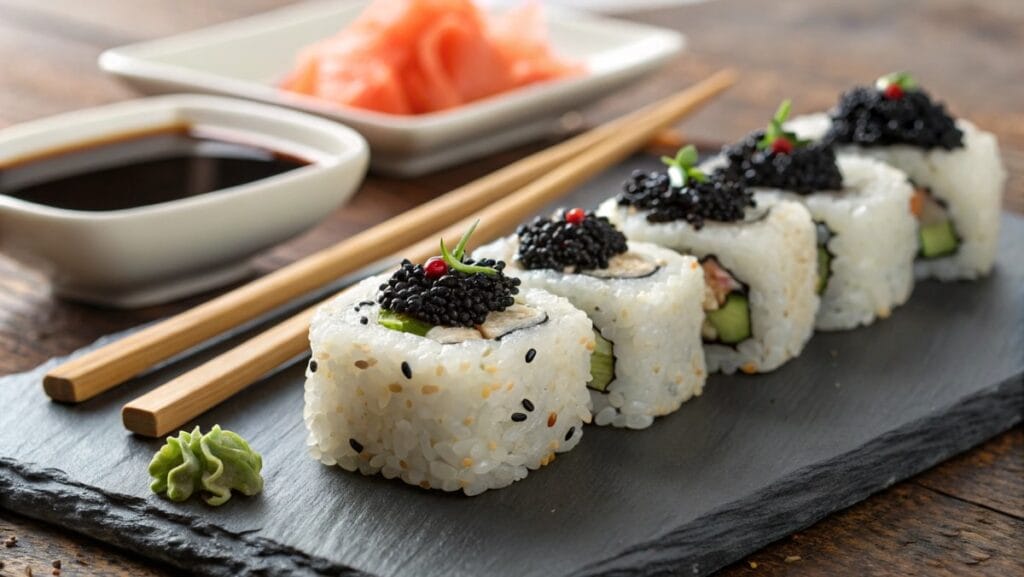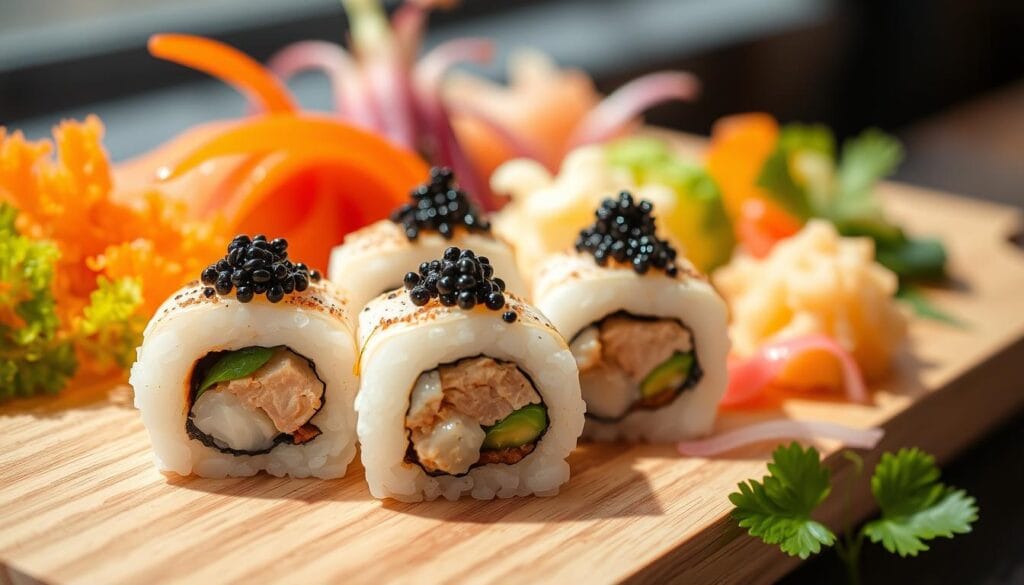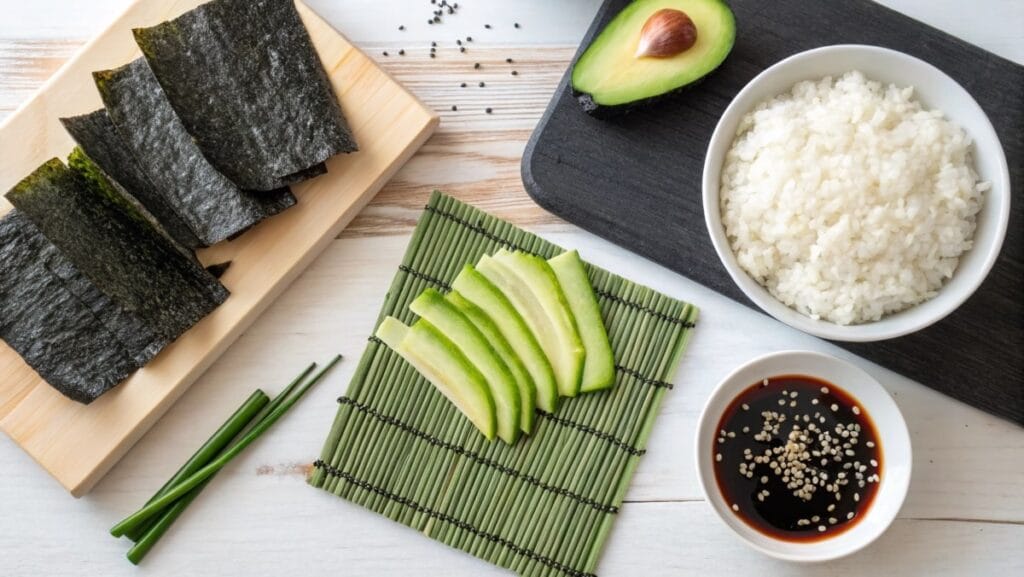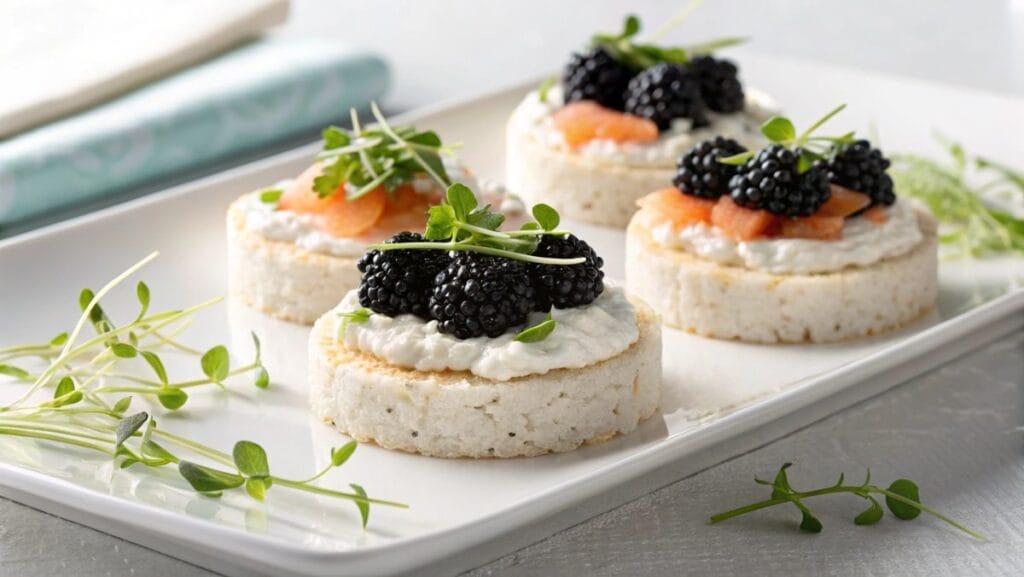Have you ever marveled at the striking elegance of sushi? The vibrant hues, delicate textures, and harmonious flavors come alive with black tobiko—a gourmet ingredient that elevates sushi to a whole new level of sophistication. Adding black tobiko to your dishes makes them more beautiful. It also adds a crunchy texture and a touch of saltiness.
As you learn more about Tobiko caviar, you’ll find out where it comes from and its health benefits. It’s used in many dishes, like tobiko sushi, around the world. It brings texture, flavor, and elegance to any meal.
Table of Contents
What is Black Tobiko?

Black tobiko, the luxurious roe of flying fish, is prized for its bold, briny flavor and signature crunch. Often dyed using natural squid ink, its deep black hue adds elegance and intrigue to dishes, making it a staple in Japanese cuisine. This ingredient is a favorite in Japanese food, especially in sushi and sashimi.
The making of Tobiko caviar is a careful process. It ensures the quality and taste of the roe. This makes it a favorite among food lovers.
Origin and Production Process
The story of Tobiko caviar starts with flying fish roe harvesting. The roe is picked by hand during the best seasons. This ensures top quality.
After picking, the eggs go through a cleaning process. They are then seasoned with soy sauce to boost their flavor.
Nutritional Benefits
Eating Japanese black caviar can be good for your health. It’s full of omega-3 fatty acids, which are good for your heart. It also has high-quality protein and important nutrients.
Learning about tobiko nutrition helps you see the benefits of Tobiko caviar. It’s a great addition to your meals.
The Unique Flavor Profile of Black Tobiko
Black tobiko boasts a bold, smoky flavor with a hint of brininess and a satisfying crunch. Compared to red tobiko’s subtle sweetness or green tobiko’s herbal zest, its intense depth makes it a standout ingredient in sushi and beyond. When you compare it to other tobiko types, you notice the flavor and texture differences. This makes each type special in its own way.
Comparing with Other Types of Tobiko
In the world of tobiko caviar, Japanese black caviar is alongside red and green varieties. Each type has its own flavor and look. For example:
| Tobiko Type | Flavor Profile | Culinary Uses |
|---|---|---|
| Black Tobiko | Briny, Smoky | Sushi, Garnishes |
| Red Tobiko | Sweet, Salty | Sushi Rolls, Sashimi |
| Green Tobiko | Spicy, Herbal | Spicy Tuna Rolls, Garnishing |
Knowing these differences helps you use Tobiko caviar in different dishes well.
How Taste Influences Food Pairings
The unique taste of Tobiko caviar goes well with many foods, especially seafood. Its rich flavor pairs well with:
- Fresh fish
- Vegetables
- Rice
- Spicy sauces
So, chefs often mix Japanese black caviar with other ingredients to make amazing dishes.
Popular Dishes Featuring Black Tobiko
Black tobiko is loved for its unique taste and eye-catching look. It’s a key ingredient in many dishes. Sushi rolls are among the most popular, thanks to Tobiko caviar’s delicate flavor and crunchy texture. It also adds a vibrant touch to these rolls.
But Tobiko caviar isn’t just for sushi. It’s also used in appetizers and small plates. It boosts both the taste and the look of these dishes.
Sushi Rolls
Sushi chefs love Tobiko caviar for its briny taste and crunchy texture. It’s a must-have in many creative sushi rolls. Here are some examples:
- Dragon Roll – Smoked eel and crisp cucumber layered with a striking drizzle of black tobiko for visual drama.
- Rainbow Roll – An artistic medley of fresh fish topped with a delicate sprinkle of black tobiko for a touch of luxury.
- Spicy Tuna Roll – Black tobiko adds crunch and balances the fiery richness of spicy tuna.
Appetizers and Small Plates
Japanese black caviar is also great in appetizers, making dishes like seafood salads and antipasto platters better. It adds flavor and makes them look good too. Here are some ways to use Tobiko caviar in small plates:
- Seafood Salad – A light salad topped with Tobiko caviar, bringing a pop of color and briny taste.
- Rice Cakes – Lightly salted rice cakes adorned with Tobiko caviar for an exquisite presentation.
- Antipasto Platters – Mixed with olives, cheeses, and meats, Tobiko caviar offers a surprising burst of flavor.

Where to Buy Black Tobiko in the U.S.
Looking for Tobiko caviar can spice up your cooking. You have many places to buy this tasty ingredient. Check out local seafood markets for fresh and high-quality options. Or, you can buy it online from gourmet food stores right from home.
Local Seafood Markets
Seafood markets often have fresh Japanese black caviar. Shopping locally lets you check the quality and freshness. Here are some tips:
- Choose markets known for their seafood.
- Ask about where their black tobiko comes from.
- Find out how they keep their products fresh.
Buying from a local market not only gets you quality Tobiko caviar. It also supports local businesses.
Online Retailers
For convenience, check out online stores. Many websites sell gourmet products, including Japanese black caviar. Look for these things:
- Check customer reviews for quality.
- See if they offer fast shipping.
- Look for guarantees on their products.
Here’s a quick comparison table of popular online retailers:
| Retailer | Product Type | Shipping Options | Customer Reviews |
|---|---|---|---|
| Trader Joe’s | Black Tobiko | Varies | 4.5/5 |
| Whole Foods | Tobiko Caviar | Fast Delivery | 4.7/5 |
| Amazon | Black Tobiko | Prime Shipping | 4.6/5 |
How to Store Black Tobiko
Storing black tobiko right is key to keeping it fresh and tasty. Knowing the best ways to store it can make your cooking better. Here are some tips to help you use and keep your black tobiko fresh for longer.
Best Practices for Freshness
For Japanese black caviar to stay fresh, start with the right fridge storage. Follow these steps to keep it in top shape:
- Refrigerate Black fish eggs right after buying. The fridge should be colder than 40°F.
- Keep it in its original bag until you’re ready to use it. This keeps air out.
- After opening, move unused tobiko to a tight container. This stops it from drying out and getting contaminated.
Tips for Long-Term Storage
If you won’t use Japanese black caviar right away, freezing is a good option. Here are some tips for freezing black tobiko:
- Freeze it in small parts. This way, you can thaw only what you need.
- Use bags or containers made for the freezer to avoid freezer burn and keep it soft.
- Mark the containers with the freezing date. This helps you know how long it’s been stored.
| Storage Method | Duration | Notes |
|---|---|---|
| Refrigeration | Up to 1 week | Keep in original packaging or sealed container. |
| Freezing | Up to 6 months | Divide into portions for easy thawing. |
Cooking with Black Tobiko

Exploring Japanese black caviar in cooking opens up many possibilities. It adds a unique flavor and striking look to dishes. It can make simple meals special and impress your guests.
Incorporating into Recipes
Black fish eggs is a great addition to many dishes. Try it in:
- Salads: Add it to fresh greens for color and flavor.
- Pasta dishes: Mix it with spaghetti and creamy sauces for depth.
- Seafood entrees: Garnish grilled fish or scallops for a visual boost.
Adding Black fish eggs to your recipes is a treat for your taste buds. It brings a unique flavor that pairs well with many ingredients.
Pairing with Other Ingredients
Think about black tobiko’s flavor when pairing it. Good matches include:
| Ingredient | Flavor Compatibility |
|---|---|
| Creamy sauces | Balance the saltiness of the tobiko with rich flavors. |
| Citrus | Complement the dish with bright acidity, enhancing the overall taste. |
| Vegetables | Add freshness and crunch while offering contrasting textures. |
These pairings not only improve your dishes but also show black tobiko’s versatility. Experiment with different combinations to find your favorite.
The Visual Appeal of Black Tobiko
Black tobiko’s striking look is a great chance for chefs to make their dishes look amazing. It’s a key part in making food visually appealing. Adding black tobiko to your dishes can make them stand out with its unique color and texture.
Presentation Techniques
There are special ways to show off Black fish eggs’s vibrant look. Here are some methods to make it pop:
- Garnishing Sushi: Sprinkling Black fish eggs on sushi rolls adds a striking contrast to the white rice, making it eye-catching.
- Finishing Touch on Plates: A small dollop of black tobiko can be a striking garnish on various dishes, like seafood and salads, adding color and texture.
- Layering: Mixing black tobiko with other ingredients creates layers that add depth and interest to a dish.
Why It Enhances Dish Aesthetics
Black tobiko’s look plays a big role in the kitchen. Chefs know that how a dish looks can really affect how people enjoy it. Black tobiko not only looks good but also makes diners want to try it. Its shiny surface catches the eye and makes any dish look better.
| Presentation Element | Effect on Dish |
|---|---|
| Color Contrast | Creates visual interest; highlights ingredients |
| Texture Variation | Adds a crunchy element; enhances mouthfeel |
| Serving Size | Affects perception of portion and elegance |
| Placement Techniques | Heightens anticipation; encourages exploration |
Health Considerations and Allergies

Adding Black fish eggs to your meals can be great, but knowing the health facts is key. This seafood treat not only adds flavor but also has good nutritional value. Yet, it might cause allergies in some people.
Potential Allergens
Since black tobiko comes from fish, it can cause allergic reactions in seafood-sensitive folks. Symptoms might include hives, swelling, or stomach problems. If you’re allergic to fish or shellfish, talk to a doctor before trying it.
Health Benefits of Consuming Tobiko
Black tobiko is packed with omega-3 fatty acids, which are good for your heart and brain. It also has protein for muscle repair and growth. Looking into black tobiko nutrition, you’ll find it’s full of vitamins and minerals, making it a healthy choice for your diet.
| Nutrient | Amount per 100g | Health Benefits |
|---|---|---|
| Calories | 250 | Energy source |
| Protein | 32g | Muscle repair and growth |
| Omega-3 Fatty Acids | 3.5g | Supports heart and brain function |
| Calcium | 50mg | Bone health |
| Iron | 1.5mg | Prevents anemia |
Knowing about potential allergens and the health perks of tobiko helps you make better food choices. This way, you can enjoy your meals while staying healthy.
The Cultural Significance of Black Tobiko
Black fish eggs is more than just a colorful and tasty food. It’s a key part of Japanese cuisine, loved for its unique taste and texture. Made from flying fish eggs, it makes traditional dishes look and taste better. It’s also a big part of sushi and other Japanese foods.
Role in Japanese Cuisine
In Japan, black tobiko has deep roots in food culture. It’s used to add crunch and flavor to sushi and sashimi. This shows the Japanese love for balance in taste, known as *umami*. The skill needed to use black tobiko highlights its importance in Japanese cooking.
Growing Popularity in Western Cooking
Black tobiko is becoming more popular in Western cooking. This shows how food cultures are mixing. Chefs in the U.S. are using it in new ways, like in salads and burgers. This shows a growing interest in Japanese flavors and ingredients.
Fun Facts About Black Tobiko
Explore the fun side of black tobiko and learn some cool facts. It comes from flying fish and is loved worldwide for its unique look and crunchy texture. It’s not just for sushi lovers; it’s enjoyed in many dishes, adding a special brininess.
Interesting Trivia
Black fish eggs’s bright color makes any dish look amazing. Its color changes based on what the fish eat, adding mystery to your meal. It also has less sodium than some fish roe, making it a great choice for those watching their salt.
Misconceptions Debunked
It’s important to clear up myths about Black fish eggs. Many think all roe is the same, but black tobiko has special health benefits. It’s packed with Omega-3 fatty acids, which are good for your heart. Knowing this, you can enjoy black tobiko without any doubts.
FAQs
What is black tobiko?
Black tobiko, also known as flying fish roe, is the eggs of flying fish. It has a unique look and a salty, smoky taste. People often use it as a garnish in sushi and other dishes.
How do I incorporate black tobiko into my cooking?
You can add black tobiko to sushi rolls, salads, or pasta. It’s a fancy topping for seafood dishes. It also goes well with creamy sauces, citrus, or veggies to make your food better.
Where can I buy black tobiko in the U.S.?
You can find black tobiko at seafood markets that sell fresh products. Online retailers also carry gourmet ingredients, making it easy to buy from home.
What are the nutritional benefits of black tobiko?
Black tobiko is packed with omega-3 fatty acids and protein. It’s a nutritious addition to many meals, helping to improve your diet.
How should I store black tobiko for freshness?
Keep Black fish eggs in the fridge to stay fresh. After opening, seal it tightly and check the expiration date. You can also freeze it, but follow the right freezing steps to keep its quality.
Conclusion
Black tobiko is more than just a garnish; it’s a culinary experience that combines bold flavors, unique textures, and striking visuals. Whether you’re elevating your sushi rolls, experimenting with creative appetizers, or garnishing gourmet dishes, black tobiko adds sophistication and depth to every bite.
Ready to dive deeper into the world of tobiko? Explore our comprehensive collection of articles and recipes at Everyday Meal Recipes to discover more ways to use tobiko and create unforgettable meals. Let your culinary imagination soar with these vibrant and versatile ingredients!
Unlock the secrets of tobiko and bring gourmet flavors to your table today. 🥢

